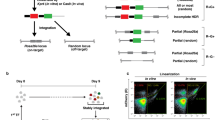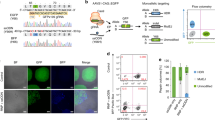Abstract
We have previously demonstrated that site-specific insertion, deletion or substitution of one or two nucleotides in mouse embryonic stem cells (ES cells) by single-stranded deoxyribo-oligonucleotides is several hundred-fold suppressed by DNA mismatch repair (MMR) activity. Here, we have investigated whether compound mismatches and larger insertions escape detection by the MMR machinery and can be effectively introduced in MMR-proficient cells. We identified several compound mismatches that escaped detection by the MMR machinery to some extent, but could not define general rules predicting the efficacy of complex base-pair substitutions. In contrast, we found that four-nucleotide insertions were largely subject to suppression by the MSH2/MSH3 branch of MMR and could be effectively introduced in Msh3-deficient cells. As these cells have no overt mutator phenotype and Msh3-deficient mice do not develop cancer, Msh3-deficient ES cells can be used for oligonucleotide-mediated gene disruption. As an example, we present disruption of the Fanconi anemia gene Fancf.
This is a preview of subscription content, access via your institution
Access options
Subscribe to this journal
Receive 12 print issues and online access
$259.00 per year
only $21.58 per issue
Buy this article
- Purchase on Springer Link
- Instant access to full article PDF
Prices may be subject to local taxes which are calculated during checkout




Similar content being viewed by others
References
Moerschell RP, Tsunasawa S, Sherman F . Transformation of yeast with synthetic oligonucleotides. Proc Natl Acad Sci USA 1988; 85: 524–528.
Campbell PP, Keown W, Lowe L, Kirschling D, Kucherlapati R . Homologous recombination involving small single-stranded oligonucleotides in human cells. New Biol 1989; 1: 223–227.
Ellis HM, Yu D, DiTizio T, Court DL . High efficiency mutagenesis, repair, and engineering of chromosomal DNA using single-stranded oligonucleotides. Proc Natl Acad Sci USA 2001; 98: 6742–6746.
Cole-Strauss A, Yoon K, Xiang Y, Byrne BC, Rice MC, Gryn J et al. Correction of the mutation responsible for sickle cell anemia by an RNA–DNA oligonucleotide. Science 1996; 273: 1386–1389.
Alexeev V, Yoon K . Stable and inheritable changes in genotype and phenotype of albino melanocytes induced by RNA–DNA oligonucleotides. Nat Biotechnol 1998; 16: 1343–1346.
Igoucheva O, Alexeev V, Yoon K . Targeted gene correction by small single-stranded oligonucleotides in mammalian cells. Gene Therapy 2001; 8: 391–399.
Igoucheva O, Alexeev V, Pryce M, Yoon K . Transcription affects formation and processing of intermediates in oligonucleotide-mediated gene alteration. Nucleic Acids Res 2003; 31: 2659–2670.
Liu L, Rice MC, Drury M, Cheng S, Gamper H, Kmiec EM . Strand bias in targeted gene repair is influenced by transcriptional activity. Mol Cell Biol 2002; 22: 3852–3863.
Li X, Costantino N, Lu L, Liu D, Watt RM, Cheah KSE et al. Identification of factors influencing strand bias in oligonucleotide-mediated recombination in Escherichia coli. Nucleic Acids Res 2003; 31: 6674–6687.
Zhang Y, Muyrers JPP, Rientjes J, Stewart FA . Phage annealing proteins promote oligonucleotide-directed mutagenesis in Escherichia coli and mouse ES cells. BMC Mol Biol 2003; 4: 1–14.
Brachman EE, Kmiec EB . DNA replication and transcription direct strand bias in the process of targeted gene repair in mammalian cells. J Cell Sci 2004; 117: 3867–3874.
Olsen PA, Randol M, Krauss S . Implications of cell cycle progression on functional sequence correction by short single-stranded DNA oligonucleotides. Gene Therapy 2005; 12: 546–551.
Wu X, Xin L, Yin W, Shang X, Lu L, Watt RM et al. Increased efficiency of oligonucleotide-mediated gene repair through slowing replication fork progression. Proc Natl Acad Sci USA 2005; 102: 2508–2513.
Brachman EE, Kmiec EB . Gene repair in mammalian cells is stimulated by the elongation of S phase and transient stalling of replication forks. DNA Repair 2005; 4: 445–457.
Dekker M, Brouwers C, Te Riele H . Targeted gene modification in mismatch-repair-deficient embryonic stem cells by single-stranded DNA oligonucleotides. Nucleic Acids Res 2003; 31: e27.
Costantino N, Court DL . Enhanced levels of λ Red-mediated recombinants in mismatch repair mutants. Proc Natl Acad Sci USA 2003; 100: 15748–15753.
Kolodner R . Biochemistry and genetics of eukaryotic mismatch repair. Genes Dev 1996; 10: 1433–1442.
Raysiguier C, Thaler DS, Radman M . The barrier to recombination between Escherichia coli and Salmonella thyphimurium is disrupted in mismatch-repair mutants. Nature 1989; 342: 396–401.
De Wind N, Dekker M, Berns A, Radman M, Te Riele H . Inactivation of the mouse Msh2 gene results in mismatch repair deficiency, methylation tolerance, hyperrecombination, and predisposition to cancer. Cell 1995; 82: 321–330.
Genschel J, Littman SJ, Drummond JT, Modrich P . Isolation of MutSbeta from human cells and comparison of the mismatch repair specificities of MutSbeta and MutSalpha. J Biol Chem 1998; 273: 19895–19901.
Umar A, Risinger JI, Glaab WE, Tindall KR, Barrett JC, Kunkel TA . Functional overlap in mismatch repair by human MSH3 and MSH6. Genetics 1998; 148: 1637–1646.
De Wind N, Dekker M, Claij N, Jansen L, Van Klink Y, Radman M et al. HNPCC-like cancer predisposition in mice through simultaneous loss of Msh3 and Msh6 mismatch-repair protein functions. Nat Genet 1999; 23: 359–362.
Lu A-L . Biochemistry of mammalian DNA mismatch repair. In: Nickoloff JA, Hoekstra MF (eds). DNA Damage and Repair, Vol.2: DNA Repair in Higher Eukaryotes. Human Press Inc: Totowa, NJ, 1998, pp 95–118.
Lahue RS, Au KG, Modrich P . DNA mismatch correction in a defined system. Science 1989; 245: 160–163.
Natrajan G, Lamers MH, Enzlin JH, Winterwerp HH, Perrakis A, Sixma K . Structures of Escherichia coli DNA mismatch repair enzyme MutS in complex with different mismatches: a common recognition mode for diverse substrates. Nucleic Acids Res 2003; 31: 4814–4821.
Acknowledgements
We thank Floris Foijer and Eva Wielders for valuable comments on the manuscript and Guus Hart for help with statistical analyses. This work was supported by grants from the Dutch Cancer Society (NKI 2000-2233) and the Netherlands Genomics Initiative (Horizon 050-71-007).
Author information
Authors and Affiliations
Corresponding author
Rights and permissions
About this article
Cite this article
Dekker, M., Brouwers, C., Aarts, M. et al. Effective oligonucleotide-mediated gene disruption in ES cells lacking the mismatch repair protein MSH3. Gene Ther 13, 686–694 (2006). https://doi.org/10.1038/sj.gt.3302689
Received:
Revised:
Accepted:
Published:
Issue Date:
DOI: https://doi.org/10.1038/sj.gt.3302689
Keywords
This article is cited by
-
Effective CRISPR/Cas9-mediated correction of a Fanconi anemia defect by error-prone end joining or templated repair
Scientific Reports (2019)
-
Truncation of the MSH2 C-terminal 60 amino acids disrupts effective DNA mismatch repair and is causative for Lynch syndrome
Familial Cancer (2017)
-
Progress and prospects: oligonucleotide-directed gene modification in mouse embryonic stem cells: a route to therapeutic application
Gene Therapy (2011)
-
Simultaneous targeted exchange of two nucleotides by single-stranded oligonucleotides clusters within a region of about fourteen nucleotides
BMC Molecular Biology (2008)
-
Progress and Prospects: targeted gene alteration (TGA)
Gene Therapy (2007)



